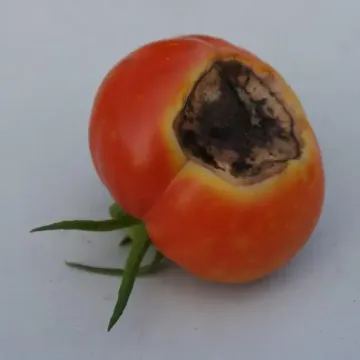Are your tomatoes turning black at the blossom end. Are you finding black spots on tomatoes. It could be a sign of blossom end rot. Sometimes it will also show as dark sunken area on tomatoes.
Blossom end rot is a common yet frustrating condition that affects tomatoes and other fruiting vegetables like peppers and squash. It manifests as a dark, sunken spot on the blossom end (the bottom) of the fruit, rendering it inedible. Though often mistaken for a disease, blossom end rot is actually a physiological disorder caused by calcium deficiency in the developing fruit. Environmental factors such as irregular watering, excessive nitrogen fertilization, and extreme soil conditions can contribute to this problem. Understanding how to prevent and treat blossom end rot can help ensure a healthy and productive tomato crop.
Ways to Prevent Blossom End Rot When Planting and Growing
- Soil Preparation
- Test Your Soil: Before planting, conduct a soil test to ensure your soil has a balanced pH (between 6.2 and 6.8) and adequate calcium levels. Adjust pH using lime or sulfur as needed, and consider adding a calcium amendment like gypsum if calcium levels are low.
- Organic Matter: Incorporate compost or well-rotted manure into your soil. This improves soil structure, promotes even moisture retention, and enhances nutrient availability, helping prevent the conditions that lead to blossom end rot.
- Consistent Watering
- Water Regularly: Uneven watering is a major contributor to blossom end rot. Water your plants consistently, aiming for about 1-2 inches per week, depending on weather conditions. Avoid letting the soil dry out completely between waterings, as this can disrupt calcium uptake.
- Mulch: Mulching around the base of your tomato plants helps to retain soil moisture and prevent fluctuations in water levels. Organic mulches like straw, leaves, or grass clippings work well.
- Fertilization Practices
- Use Balanced Fertilizers: Avoid fertilizers high in nitrogen, especially ammonium-based fertilizers, as excess nitrogen can promote rapid foliage growth at the expense of fruit development, leading to calcium deficiency. Opt for a balanced fertilizer with a moderate nitrogen level and adequate phosphorus and potassium.
- Calcium Supplements: If your soil test reveals low calcium levels, consider adding calcium supplements to the soil before planting. These may include gypsum, bone meal, or calcium nitrate.
- Planting Techniques
- Proper Spacing: Overcrowded plants can lead to competition for water and nutrients, increasing the risk of blossom end rot. Space your tomato plants at least 18-24 inches apart to allow for good air circulation and root development.
- Deep Planting: When transplanting, plant tomatoes deeply to encourage a strong root system. The more extensive the root system, the better the plant can access water and nutrients, reducing the chances of calcium deficiency.
Ways to Treat Blossom End Rot Once Recognized
- Remove Affected Fruit
- Once you notice blossom end rot on a tomato, remove the affected fruit immediately. This allows the plant to focus its energy on healthy fruit development rather than trying to ripen damaged fruit.
- Correct Watering Practices
- Water Deeply and Consistently: If irregular watering is the culprit, adjust your watering practices immediately. Ensure your plants receive deep, consistent watering to maintain even soil moisture. A drip irrigation system or soaker hose can be especially effective in delivering water directly to the roots without over-saturating the foliage.
- Apply Calcium Foliar Sprays
- Calcium Sprays: Foliar calcium sprays can help alleviate calcium deficiency, though they are not a cure-all. These sprays are most effective when applied early in fruit development. However, they may not completely prevent blossom end rot if the underlying issue (irregular watering, poor soil conditions) isn’t addressed.
- Mulch and Prune
- Maintain Mulch: Ensure your mulch layer is sufficient to keep the soil consistently moist. A 2-3 inch layer around the base of the plant helps regulate moisture levels.
- Prune as Needed: While it's important not to over-prune, selective pruning to remove excess foliage can help the plant focus on fruit production and nutrient absorption, reducing the risk of blossom end rot.
- Adjust Fertilization
- Stop Over-Fertilizing: If you suspect that excess nitrogen is contributing to the problem, scale back on high-nitrogen fertilizers. Instead, switch to a balanced or low-nitrogen fertilizer, ensuring the plant gets all essential nutrients, especially calcium and potassium.
- Monitor and Adjust Soil Conditions
- Test and Amend Soil: If blossom end rot persists, consider testing your soil again to ensure proper nutrient levels. Amending the soil with gypsum or other calcium-rich supplements may be necessary for future planting seasons.
Conclusion
Blossom end rot can be disheartening for tomato gardeners, but with proper prevention techniques and timely treatment, it can be managed effectively. By ensuring consistent watering, maintaining balanced fertilization, and addressing calcium needs in the soil, you can significantly reduce the risk of this condition. Remember that healthy soil and consistent care are the foundations of a thriving tomato garden, and with attention to detail, you can enjoy a bountiful harvest of delicious, rot-free tomatoes.

